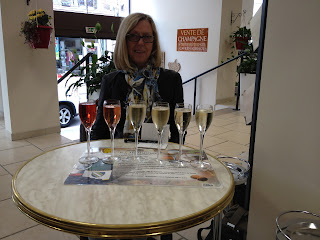So it comes as no surprise that we decided to escape the hustle and bustle of Paris to visit the "Mecca" of fizz enthusiasts, Épernay, the capital of the region Champagne-Ardenne.
It takes about 1.5 hours by train (TER leaving from Gare de l'Est). So far we've figured out that the train system around here comprises Metro (underground system for getting around the centre of Paris), RER services the outer suburbs of Paris and contains 5 lines, TER which is a regional train system and TGV which is the famous high speed (maximum normal operating speed 320 km/h), inter-city trains.
There is a famous street called Avenue de Champagne.
where you will find the head office of Moet et Chandon. You can do a tour of the Moet caves where the champagne is stored.
A. Bergere
In Ave de Champagne, we found a Champagne house called A.Bergere where we had a tasting of their vintage champagnes and found out that they have a small hotel attached.
They took us on a tour of the hotel and I could see that it was MUCH BETTER than where we were staying and had a cost of about 100 euro per night.
If you are planning to go to Eperney I'd suggest staying here. Their website is http://www.champagne-andrebergere.com. It's in French so if you click on the "Gites" link you can see more about the hotel. Here is a couple of photos of this place (by the way the champagne was so good we bought a bottle).
Here's the hotel.
The picture on the wall shows the evolution of the grape from a bud on the vine to the full bunch.
Moët et Chandon
You have to visit this place. Take the Vintage option and at the end of the tour you get a couple of glasses of vintage Moët well worth the cost of the visit. Claude Moët started the company in 1743.
The Chandon part of the name comes from a son-in-law who became a co-owner in mid-1800.
Here's a photo of the Moët caves:
It's an interesting experience to walk where hundreds of years ago people like Napoleon 1st walked (he was a big fan of Moët). Here's an example: in the Moët caves there is a barrel of port from Portugal that was sent as a present to Napoleon in 1810. After Napoleon and his mates (I suspect Moet was one of them) drank it dry, they kept the barrel in the cave as a "momento":
Next we asked the guy who ran / owned the hotel we stayed at to organise a taxi to take us on a bit of a tour. We asked that the driver speak English. The driver turned out to know a couple of English words such as "train" (which happens to be the same in French) so for two hours I sat in the front (so I could hear better) and translated what was being said to Jenni in the back.
 We wanted to drive amongst the vines and do different things so the driver kindly took us into some Moet vineyards and cut off a couple of bunches of chardonnay and pinot noir grapes (the harvest starts next week so it was "just in time") for us to taste. They've had a wet summer so the vines have grown a lot of leaves and not so many grapes so this year the yield will be low (not sure of the quality either):
We wanted to drive amongst the vines and do different things so the driver kindly took us into some Moet vineyards and cut off a couple of bunches of chardonnay and pinot noir grapes (the harvest starts next week so it was "just in time") for us to taste. They've had a wet summer so the vines have grown a lot of leaves and not so many grapes so this year the yield will be low (not sure of the quality either): The grapes were surprisingly edible but as you can see quite small compared to normal table grapes.
Dom Perignon (1638 - 1715) was the monk (at the Abbey in village Hautvillers) who invented the second fermentation process which gives rise to the bubbles in champagne. Moet and Chandon purchased the abbey in which the monk was buried to preserve it. The village is quite beautiful and worth visiting.
 You can go into the abbey, Dom Perignon is buried in the abbey as a sign of respect by the church at the time (they must have loved bubbles too).
You can go into the abbey, Dom Perignon is buried in the abbey as a sign of respect by the church at the time (they must have loved bubbles too).There are quite a few wine shops that provide a champagne tasting with some thing to eat (fromage, charcuterie etc). The champagnes we tasted (from right to left) were 100% chardonnay, 100% pinot noir, 100% pinot meunier, a blend of these, then two roses one pinot noir and the last one pinot meunier. Our favourites were the first and last glasses with the blend being the third favourite.









No comments:
Post a Comment